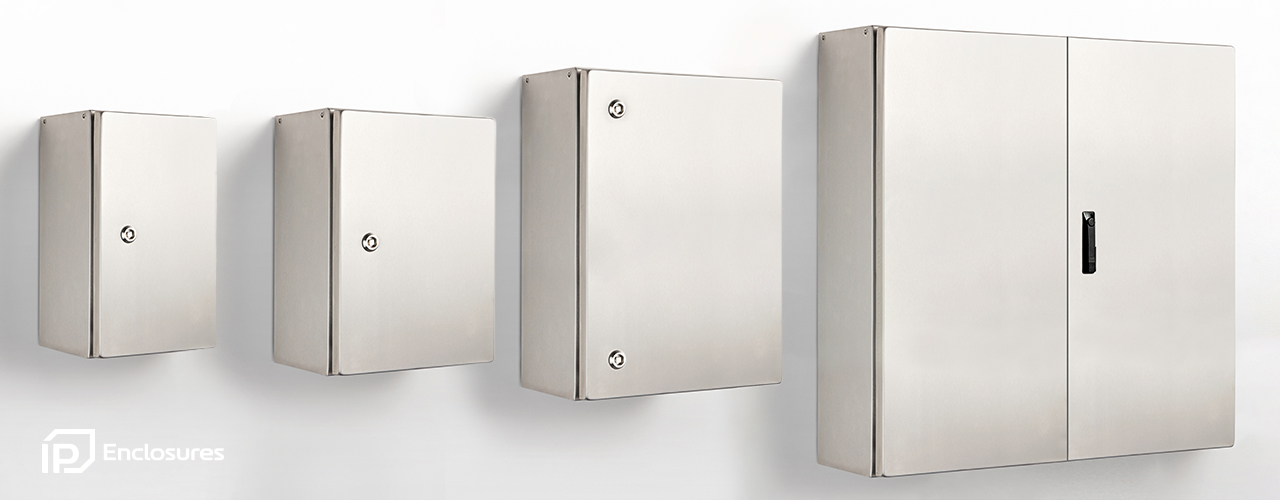
The Selection and Care of Stainless Steel Electrical Enclosures
Selecting the correct material for electrical enclosures is critical for ensuring long-term performance in demanding environments. Material choice must reflect the application, environmental exposure, and installation location. Enclosures must withstand mechanical, electrical, thermal, and environmental stresses, particularly corrosion. This guide outlines essential considerations for selecting and maintaining stainless steel electrical enclosures.
304 vs 316 Stainless Steel: Choosing the Right Grade
Grade 304 / 304L: General Industrial Use
Grade 304 is the most widely used stainless steel. Grade 304L, a low-carbon variant, offers improved weld corrosion resistance. These grades provide excellent corrosion protection in many applications including:
- Food and beverage processing
- Chemical and petrochemical industries
- Mineral processing
- General industrial environments
Although more expensive than mild steel, they are more cost-effective than Grade 316. However, 304/304L should not be used in:
- Coastal or marine environments
- High-temperature areas (>50 °C) with chlorides
Grade 316 / 316L: Marine and Harsh Industrial Environments
Grade 316 includes molybdenum, which significantly increases corrosion resistance, especially in chloride-rich environments. Grade 316L, its low-carbon variant, is preferred for welded assemblies. These grades are ideal for:
- Marine and coastal areas
- Offshore and industrial sites with chlorides
- High-humidity or salt-laden environments
316/316L enclosures resist pitting and crevice corrosion more effectively than 304. They also remain non-magnetic after fabrication, whereas 304 may become partially magnetic.
Summary of Material Suitability
| Grade | Use Case | Limitations |
| 304/304L | Indoor or mild outdoor industrial | Avoid in chloride-heavy, marine, or hot environments |
| 316/316L | Coastal, marine, or chemical exposure | Higher cost but essential for durability |
Handling and Storage: Avoiding Surface Damage
Stainless steel must be handled with care to maintain its corrosion resistance. Improper storage or handling may introduce contamination or physical damage.
Best Practices:
- Handle stainless enclosures separately from carbon steel components.
- Use soft slings, foam padding, or coated hooks during lifting.
- Avoid dragging enclosures across abrasive or metallic surfaces.
- Place enclosures on clean, debris-free work surfaces.
- Protect surfaces from forklift tines, strapping, or hard contact points.
Moisture, chlorides, and pollutants accelerate corrosion. Always store enclosures in a dry, clean, and protected environment.
Contamination Risks: Cross-Contamination and Prevention
Stainless steel is vulnerable to contamination by carbon steel particles, chlorides, and aggressive chemicals. Cross-contamination can lead to premature corrosion.
Prevention Tips:
- Isolate stainless steel from carbon steel dust, filings, and tools.
- Avoid using shared tools between carbon steel and stainless components.
- Do not weld, grind, or cut carbon steel near stainless enclosures.
- Use plastic or foam protection during transport to prevent contact with steel strapping.
For chemical-intensive sites, consult chemical compatibility tables to select appropriate materials.
Galvanic Corrosion: Managing Dissimilar Metals
Galvanic corrosion occurs when dissimilar metals contact each other in the presence of moisture. Stainless steel can accelerate the corrosion of more sacrificial materials like aluminum or zinc.
Conditions Required for Galvanic Corrosion:
- Contact between dissimilar metals
- Significant potential difference
- Presence of a conductive liquid (e.g., saltwater)
Prevention Measures:
- Use insulating gaskets or washers between metals.
- Minimize moisture entrapment and ensure proper drainage.
- Apply protective coatings to less noble metals.
- Ensure the sacrificial metal has a large surface area relative to stainless steel.
Install rain hoods or shelters in coastal and industrial areas to reduce exposure to conductive liquids such as rainwater and salt spray.
Coastal Corrosion & Tea Staining: Causes and Prevention
Tea staining is a superficial brown discoloration caused by salt deposits and humidity. It does not affect structural integrity but can detract from appearance.
Contributing Factors:
- Salt-laden air and water
- High temperatures and humidity
- Rough surface finishes
- Lack of regular cleaning
Prevention:
- Use 316/316L stainless in coastal areas (up to 20 km from sea)
- Avoid flat-top surfaces where water pools—use sloped roofs or rain hoods
- Opt for smooth finishes (0.2–0.4 µm Ra) to resist salt buildup
- Clean regularly with contaminant-free water and dry thoroughly
Standard Reference:
AS/NZS 2312 states that coastal corrosion can occur up to 20 km inland, depending on conditions.
Passivation:
If tea staining occurs, clean and passivate using a citric acid-based solution to restore the protective chromium oxide layer.
Cleaning and Maintenance: Best Practices
Routine cleaning extends the lifespan and appearance of stainless steel enclosures. Use non-abrasive methods and avoid harsh chemicals.
Cleaning Guidelines:
- Use warm water with mild detergent.
- Wipe along the grain using a soft cloth or non-abrasive sponge.
- Rinse with clean or deionized water.
- Dry thoroughly with a microfiber cloth.
- Avoid steel wool, hydrochloric acid, and reused cloths.
Cleaning Frequency Recommendations:
- Coastal environments: Every 1–3 months
- Industrial areas: At least every 3 months
- Rural/suburban areas: Annually
Stainless Steel Fasteners: Preventing Galling
Stainless steel fasteners may seize during tightening (galling), especially under pressure or without lubrication.
To prevent galling:
- Keep threads clean and debris-free.
- Avoid overtightening.
- Use anti-seize lubricant or thread compound.
- Use matched stainless steel grades for bolts and nuts.
Environmental Design Considerations
Designing enclosure installations should consider local temperature, chemical exposure, and moisture levels.
Design Best Practices:
- Use shelters, sunshades, and rain hoods.
- Ensure proper drainage to avoid pooling at the base.
- Prevent buildup of leaves, dust, or chemicals.
- Match fastener grade to enclosure grade to avoid galvanic corrosion.
- Consult chemical compatibility tables for cleaning agents and pollutants.
- Use acid-resistant coatings where needed.
Quick Maintenance Checklist for Long-Term Durability
- Choose the correct grade: 304 for general use, 316 for harsh environments.
- Clean monthly in marine or industrial areas.
- Prevent contamination from carbon steel tools and surfaces.
- Isolate dissimilar metals or use insulating materials.
- Install enclosures with overhead protection where possible.
- Inspect regularly for signs of pitting, corrosion, or tea staining.